Over the past decade, biodynamic wine has exploded in popularity, particularly amongst a younger generation of wine drinkers. Having spoken to a selection of top producers that follow biodynamic farming, Wine Lister’s latest investigation attempts to explore the practice further, and better understand the shared values of this often-misunderstood philosophy.
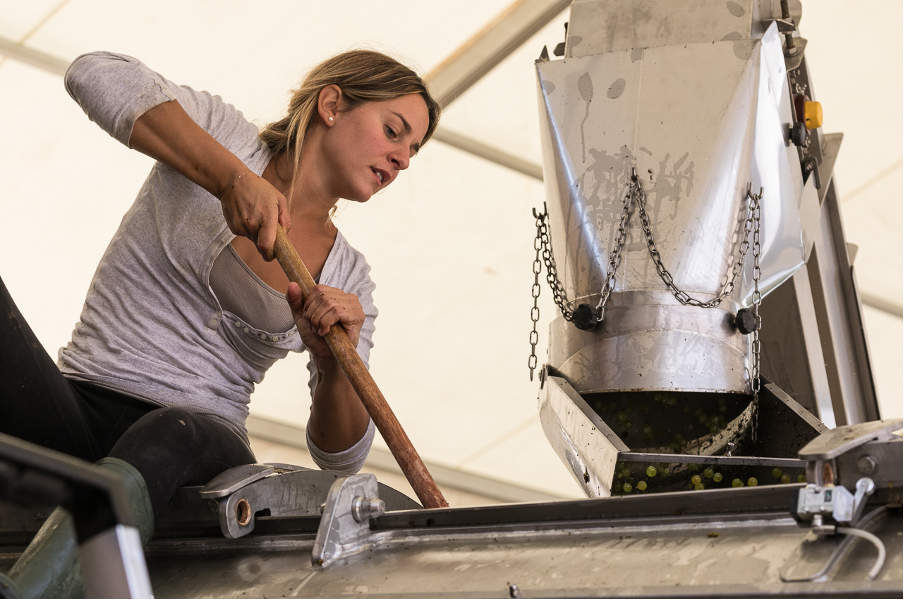 The biodynamic calendar: racking at Comtes Lafon (pictured) is timed according to the lunar phases (Photo: Jean Chevaldonné)
The biodynamic calendar: racking at Comtes Lafon (pictured) is timed according to the lunar phases (Photo: Jean Chevaldonné)
Often associated with organic winemaking, biodynamics also dictates the avoidance of pesticides and chemical fertiliser, and many of its wines are therefore organic in practice. Certified by independent associations (e.g. Demeter and Biodyvin) rather than the government, biodynamics goes one step further, providing a more holistic approach to farming that attempts to embrace all natural biological processes. Coined in 1924 by Rudolf Steiner – an Austrian philosopher and scientist – biodynamics draws on the specific belief that all living species experience constant transformation, due to physical, metaphysical, and cosmic realities acting upon them. While it is not essential for certification, most biodynamic producers therefore follow the biodynamic lunar calendar, which dictates the optimum days for viticulture and winemaking activities, based on the moon’s cycle.
In Burgundy, Comtes Lafon plans its planting, pruning, harvest, racking, and bottling according to the lunar calendar (see photo above), despite not being certified officially. Having shifted to biodynamic farming in 1998, owner and winemaker, Dominique Lafon, tells us that he was initially inspired by the practice in several of his friends’ vineyards at the time, and was “impressed by the way the vines behaved”. He states that while it is more time consuming, biodynamic farming provides him “pleasure to work closer to the vineyards, following their natural rhythms”.
Among a list of other principles, biodynamic producers must complete a cow horn preparation, otherwise known as process 500, in which manure is packed into the horn of a female cow and buried under the vines for six months. The horns are then dug up, and the content of the horns is combined with water and sprayed across the vineyards, in the belief that the solution enhances plant growth and improves the quality of the crops. Dominique tells us that while some results of biodynamic farming can be seen “rapidly, within the first year”, process 500 begins to change the soil “after three years or so, and is fully effective after 10 years”.
In Bordeaux, Château Palmer also completes the cow horn preparation (pictured below) – the Margaux estate began experimenting with biodynamics in 2008, adopting it completely in October 2013, and releasing its first certified vintage in 2018. Winemaker Thomas Duroux, tells us that the adoption of such biodynamic principles has yielded “results in the vineyard” and encouraged “better quality soil”, while helping him to achieve his goal of “growing a vineyard without any use of chemicals”. Explaining the difference between organic and biodynamics, Duroux notes that the latter is “a different way to see agriculture”, and that when you apply biodynamic principles, “you see the farm as an ensemble”. This resonated across several other biodynamic producers, who similarly considered biodiversity to be at the core of this mode of farming.
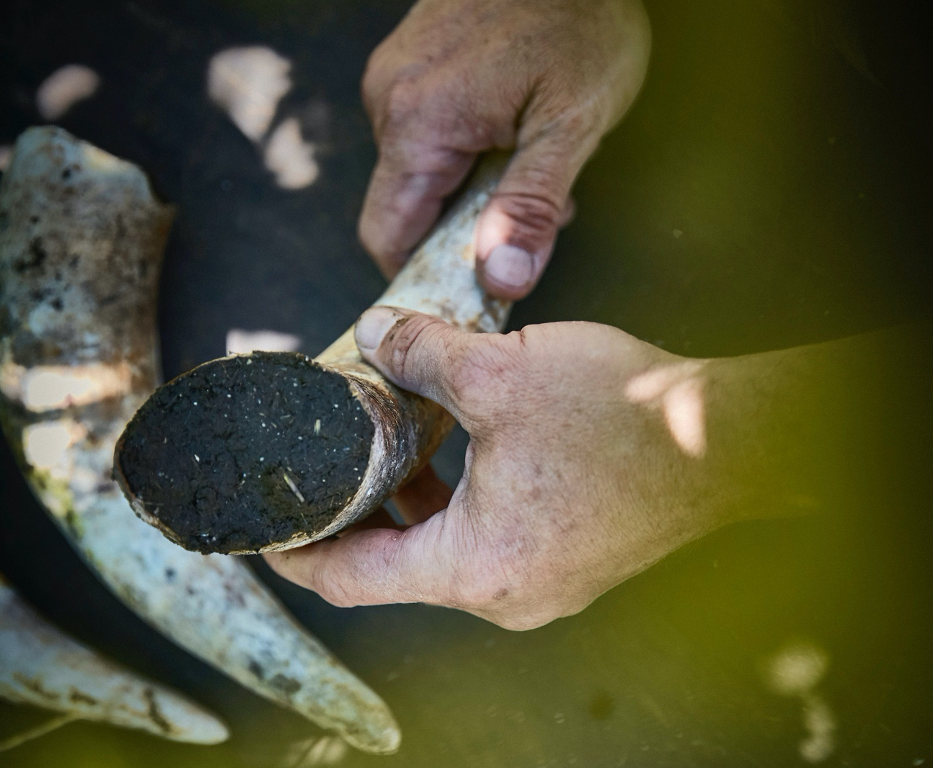 Process 500: biodynamic compost preparations at Château Palmer
Process 500: biodynamic compost preparations at Château Palmer
Indeed, Elisabetta Foradori tells us that since its conversion, Foradori has founded a new focus on biodiversity and sustainability, with livestock now used to produce dairy products and compost for the vineyard. She began to introduce biodynamic principals into the family estate in 1999, converting the whole property in 2002, and eventually achieving certification in 2009. Foradori tells us that she had begun to feel “disconnected to the plants after many years of working in wine”, and biodynamic viticulture allows her to “go into the deepness of the life of the plant and its soil”. She states that the practice has catalysed an “evolution in the fertility of the soil”, watching vine roots “grow deeper and deeper”.
Further south in Chianti, Querciabella conversely practices a “cruelty-free” biodynamics, according to its team, without the use of manure or animal remnants in the soil. Winemaker Manfred Ing states that while “eliminating all of the animal-based preparations”, the estate has implemented a strict cover crop preparation, planting up to 35 different plants across its vineyards, depending on the soils and the grapes that grow in each plot. He states that this improves the quality of the land, whilst adhering to the biodynamic principle of “getting as much quantifiable life in the soil and the vineyard as possible.”
Following the general sentiment of other biodynamic producers, Elisabetta Foradori states biodynamic farming enables the wine to “reflect the message of the terroir” while encouraging “purity and character”. This was particularly pertinent to one of Burgundy’s biodynamic pioneers, Leroy – speaking to Wine Lister, the team notes that biodynamic farming indeed helps the property to better “express the character” of its respective sites. Having implemented biodynamic farming since the day it was purchased by Lalou Bize-Leroy in 1988, the team tells us that “no one else was even organic” in the region at that time, and people “thought it was crazy” to neglect the use of fertiliser and risk decreased yields. They explain that Burgundy is an “ideal place” for biodynamic farming, through its ability to express the disparities between the different vineyard holdings of the same Burgundy varietal – a “true test of where the wine comes from”.
While biodynamic producers approach the practice with variable interpretations, its practitioners are nonetheless enthusiastic about its results. With an increasing number of producers adopting this mode of farming, we look forward to witnessing its wider recognition across the fine wine industry in years to come.
Wine Lister’s latest MUST BUY update identified 38 new wines that show quality and value within their respective vintages and appellations, and wide praise from the international trade. To help you discover these new picks, this week’s blog takes a deep dive into the latest MUST BUY wines and their geographical composition.
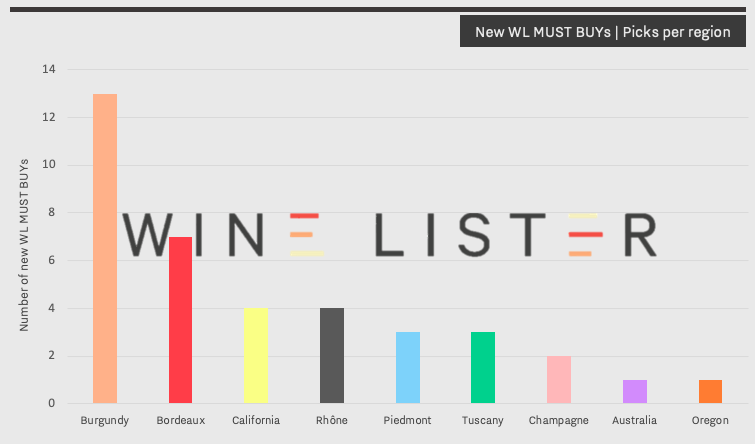
Pinot Noir picks
Burgundy dominates the new MUST BUY hoard with 13 entries, including eight reds. The perfect pick for an opulent occasion, the 1978 Romanée-Conti Richebourg costs £1,434 per bottle (in-bond), and was described by Wine Lister partner critic, Jancis Robinson, as “very long with smoothness, sweetness and unctuousness”. Sharing its WL score of 96, the 2010 Volnay Clos des Ducs from the Côte de Beaune’s red producer of reference, Marquis d’Angerville, provides a more affordable option at £250 per bottle (in-bond), but may merit a little patience.
Outside of Pinot Noir’s original homeland are some new MUST BUYs of brilliant quality and impressive value for money. California’s 2016 Au Bon Climat Isabelle Pinot Noir has a WL score of 94, and was described by Wine Lister partner critic, Antonio Galloni, as “racy, perfumed and beautifully layered”, with notes of “orange peel, tobacco, blood orange, spice, star anise and new oak” throughout. It can be purchased for less than five times the price of the aforementioned Volnay, by the case of six for £262 (in-bond) from Jeroboams.
Travelling north within the US brings us to Oregon’s latest MUST BUY entry – the 2016 Cristom Louise Vineyard Pinot Noir. While more expensive than its Californian counterpart for the same WL score, Cristom’s position as the leading producer in the Willamette Valley, alongside its closer proximity to Burgundy’s cool-climate restrained style, makes it more than worth the c.35% premium. It is available to purchase for c.£60 per bottle (in-bond) from WineBuyers.com.
The best of Bordeaux blends
Bordeaux offers seven new MUST BUYs this week, including two Left Bank Value picks; 2019 Haut-Bages Libéral and 2015 Capbern. With a WL score of 92, the former addition was released en primeur two months ago, and described by James Lawther for JancisRobinson.com as, “busy and expressive on the nose with vineyard-fresh dark fruit, black-olive and mineral notes”. Labelled by Lawther as the “best in recent years”, this gem from Bordeaux’s prominent promotors of biodynamic viticulture, Gonzague and Claire Lurton, has a bright future ahead. It can still be bought en primeur through Justerini & Brooks for £142.50 per six (in-bond).
The 2010 Vieux Château Certan also appears in the latest MUST BUY update, 10 years on from the iconic vintage. It provides a more lavish option for the Bordeaux buyer, receiving a WL score of 96 at £216 per bottle (in-bond). Moving across the border into Tuscany, the 2010 Sassicaia also offers a more luxurious alternative to the Bordeaux blend. Comprising of 85% Cabernet Sauvignon and 15% Cabernet Franc, it was described by Antonio Galloni as, “just beginning to show the first signs of aromatic development”, including hints of “sweet tobacco, mint, pine, dried cherries and licorice”. It achieves a WL score of 95, and is available to purchase by the case of six for £915 from Goedhuis & Co.
Choosing Chardonnay
Back to Burgundy, and the new white MUST BUYs this week offer opulence from three iconic Meursault producers; 2015 Roulot Charmes, 2010 Comtes Lafon Genevrières, and 2017 Arnaud Ente Les Petits Charrons are all exceptional choices, albeit for an average price of £492 per bottle (in-bond). Further north, two entries hail from Chablis, and the appellation’s original historic vineyard, Les Clos; 2014 Laroche Les Clos, and 2010 Christian Moreau Père et Fils Les Clos. For those who enjoy a more pure, lean, and mineral style of white wine, the Chablis MUST BUYs exhibit notable value within their appellation and achieve higher WL scores than their buttery Meursault counterparts. The latter can be bought by the case of 12 from Cru World Wine for £871 (in-bond).
California’s latest white MUST BUY hails from Kistler Vineyard; a cult producer known for its emulation of pure and balanced Burgundian Chardonnays, over the rich and oaky Californian style. The 2017 Kistler Vineyards Dutton Ranch Chardonnay achieves a WL score of 96, and is labelled by Antonio Galloni as “such an intriguing wine because of the way it is airy and lifted and yet also so deep in feel”. Providing a less expensive alternative to Côte d’Or whites, it is priced at £133 per bottle (in-bond).
Also featured in the list of new MUST BUYs are: 2009 Abreu Madrona Ranch Cabernet Sauvignon, 1989 Bollinger Grande Année, 1996 Bruno Clair Chambertin Clos de Bèze, 2006 Cavallotto Barolo Vignolo Riserva, 2013 Ceretto Barolo Brunate, 2012 Conti Costanti Brunello di Montalcino Riserva, 1996 Dunn Vineyards Howell Mountain Cabernet Sauvignon, 2014 Duroché Chambertin Clos de Bèze, 2017 Georges Mugneret-Gibourg Clos de Vougeot, 2012 Jacques-Frédéric Mugnier Chambolle-Musigny Les Amoureuses, 2014 Jean Grivot Richebourg, 2010 Jim Barry The Armagh Shiraz, 2017 Joseph Drouhin Chambolle-Musigny Les Amoureuses, 1996 Lafite Rothschild, 2008 Lafleur, 2016 Le Macchiole Paleo Rosso, 2016 l’Evangile, 2006 Louis Roederer Cristal Rosé, 2018 Marc Sorrel Hermitage, 2013 M. Chapoutier Hermitage Ermitage Blanc De l’Orée, 2016 M. Chapoutier Hermitage Ermitage Le Méal, 2012 Roagna Barbaresco Pajè Vecchie Viti, 2016 Valandraud, and 2009 Vincent Paris Cornas La Geynale.
With so many interesting offers coming in from different merchants, it can be tricky to keep track of what wine you have, let alone where it is, and when it should be drunk. To help you get the most out of your wine collection, Wine Lister has opened up its data analysis and fine wine expertise to private clients, who can now commission all kinds of portfolio analysis, from detailed geographical split and purchase advice, to investment forecasting and a fully-fledged “drink vs. sell” plan.
Wine Lister’s “fantasy cellar”
The current list of Wine Lister MUST BUYs – wines showing notable quality and value within their respective vintages and appellations, and wide praise from the international trade – is 1,728 picks strong. While the Wine Lister team would love to own (and enjoy) all of them, below is a short selection to be put away and enjoyed at their best in five, ten, and twenty years, respectively.
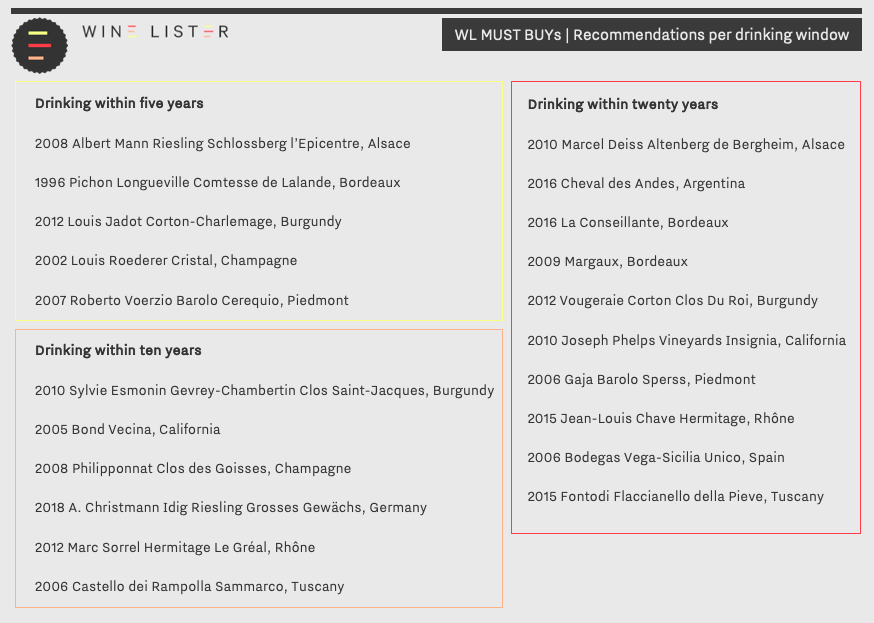
Riesling to reserve
With remarkable ageing potential, and good value across the board, Riesling constitutes a brilliant white addition to any wine collection. To be opened within ten years, the 2018 A. Christmann Idig Riesling Grosses Gewächs hails from Germany’s famed Mosel, and is described by Wine Lister partner critic, Jancis Robinson as “the thinking-person’s Riesling”. She notes the “understatement of individual components” in the wine, “which allows the taster to focus on balance and elegance”. Creeping over the border into the Alsace, where Riesling tends to be drier in style, Albert Mann’s 2008 Schlossberg l’Epicentre is ready but will improve – offering optimum enjoyment within the next five years. Another Alsatian, the 2010 Marcel Deiss Altenberg de Bergheim can endure another 20 years of ageing, also providing a reliable white to add to any cellar. Wine Lister partner critic, Antonio Galloni, describes its “perfumed aromas of nectarine, apple blossom, minerals and honey”, calling it “vibrant and penetrating”. With notable value for their quality, the three Rieslings achieve a shared WL score of 96, at £54, £98, and £59 per bottle (in bond), respectively. For something to stash away, the latter is available by the case of six from Millésima UK.
Burgundy on standby
Louis Jadot Corton Charlemagne 2012 is a similarly reliable white to be stored in the cellar, achieving a WL score of 95 at £126 per bottle (in-bond). Barrel-fermented and aged for a further eight to ten months in 100% new oak barrels, the wine has developed complexity and enhanced ageing potential. Production in 2012 was kept notably small – indeed winemaker Frédéric Barnier states, “it is critical to control the yields in Corton-Charlemagne to make a wine of real Grand Cru quality.” It can be purchased by the case of 12 from Fine+Rare Wines, and can be opened within five years. Burgundy also offers an abundance of reds with promising ageing potential, including the 2010 Sylvie Esmonin Gevrey-Chambertin Clos Saint-Jacques, and the 2012 Vougeraie Corton Clos Du Roi. Both wines achieve a WL score of 95, at £192 and £90 per bottle (in-bond), respectively.
Champagne to store
A sure pick to pop open within five years, the 2002 Louis Roederer Cristal was aged on lees for six years, before being matured for a further eight years in bottle after its disgorgement in 2009. Wine Lister partner critic, Jeannie Cho Lee notes that it is a “gorgeous Cristal with a fine line of acidity running through it – it vibrates on the palate”. With a WL score of 96, at £192 per bottle (in-bond), it is available in cases of three from Vinum Fine Wines. With an identical WL score of 96, the 2008 Philipponnat Clos des Goisses can be acquired by the case of six for £850 (in bond) from Justerini & Brooks, to be enjoyed within the next decade.
New World to wait for
For some New World picks that are worth putting away for the future, Napa Valley offerings include the 2005 Bond Vecina (owned by the famed Harlan family) and the 2010 Joseph Phelps Vineyards Insignia. In regards to the former, Antonio Galloni stated that he would “prefer to cellar it, as the future for this wine is unquestionably very, very bright”. With a WL score of 97, at £347 per bottle (in-bond) it is an opulent option to be enjoyed within the next twenty years. Of the 2010 Joseph Phelps Vineyards Insignia, Galloni states similarly that “the 2010 will enjoy a long drinking window once it softens”. Achieving a WL score of 96, at £158 per bottle (in-bond), it is available in cases of six from Goedhuis & Co.
Also featured in the above MUST BUY recommendations are: 2016 Cheval des Andes, 2016 La Conseillante, 2015 Fontodi Flaccianello della Pieve, 2015 Jean-Louis Chave Hermitage, 2012 Marc Sorrel Hermitage Le Gréal, 2009 Margaux, 2007 Roberto Voerzio Barolo Cerequio, 2006 Bodegas Vega-Sicilia Unico, 2006 Castello dei Rampolla Sammarco, 2006 Gaja Barolo Sperss, and 1996 Pichon Longueville Comtesse de Lalande.
For personalised, impartial fine wine purchase recommendations, as well as further wine collection analysis, get in touch with our team at team@wine-lister.com, or download the full Cellar Analysis information pack.
Part I of Wine Lister’s annual in-depth Bordeaux report: For better, for worse, examines the state of the market for Bordeaux wines, in the context of 2019 en primeur.
As well as providing insight into the wine trade’s latest position on key wines of the region, the study examines Bordeaux’s disconnect between consumer popularity and its market performance at the start of 2020 (exacerbated by recent macro-economic hits to the UK, Hong Kong, and the US).
As illustrated below, Bordeaux has achieved the slowest price growth on the secondary market since May 2014, while Piedmont has seen the most impressive growth – likely due to increasing attention given to the region, and the rarity factor of many of its top wines, from which Burgundy also benefits.
 The price performance of Bordeaux compared to four other key fine wine regions: Burgundy, California, Piedmont, and Tuscany. The price indices comprise the top five wine brands in each respective region.
The price performance of Bordeaux compared to four other key fine wine regions: Burgundy, California, Piedmont, and Tuscany. The price indices comprise the top five wine brands in each respective region.
A glance at its price performance since May 2019 tells a similar, if more unnerving story – Bordeaux has floundered over the past year, down nearly 5%.
Despite its price performance difficulties, Bordeaux nonetheless continues its legacy as the most popular wine region by a large margin, based on monthly searches made on Wine-Searcher.
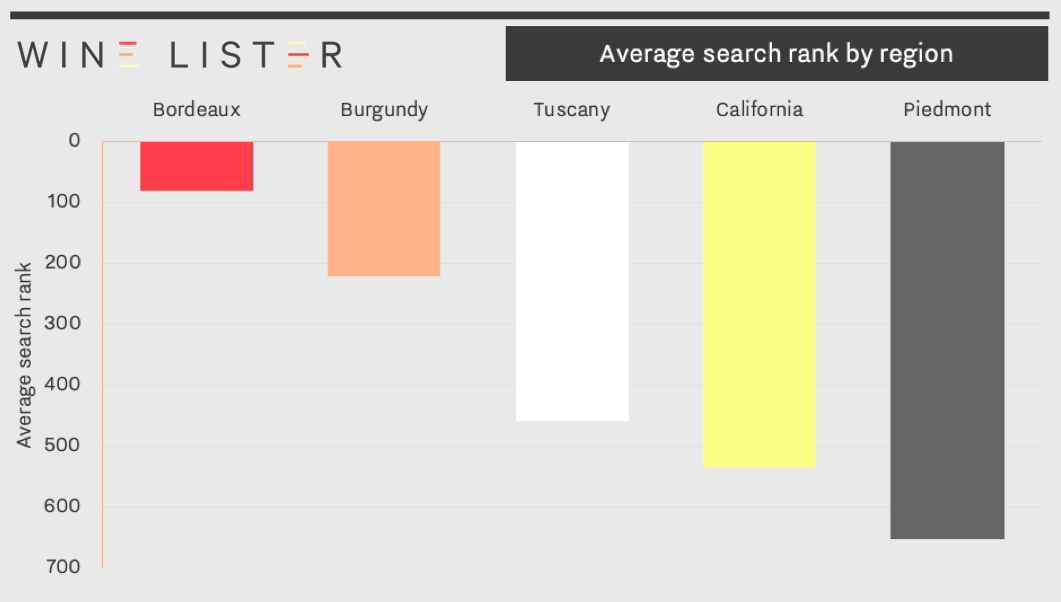 The average search rank of Bordeaux compared to four other key fine wine regions: Burgundy, California, Piedmont, and Tuscany. Results are based on the average searches on Wine-Searcher for the 50 top-scoring wines per region over the last year.
The average search rank of Bordeaux compared to four other key fine wine regions: Burgundy, California, Piedmont, and Tuscany. Results are based on the average searches on Wine-Searcher for the 50 top-scoring wines per region over the last year.
Irrespective of its price performance struggles, Bordeaux remains a focus of fine wine buyers – within the trade and beyond – all over the world. The en primeur campaign is a wheel that just keeps on turning, even in spite of a global pandemic. Trade and consumers alike can’t help but back Bordeaux, for richer and poorer.
More insight into the success of the 2019 en primeur campaign will be included in Part II of this study. In the meantime, visit the Analysis page to purchase Part I, or download using your Pro subscription (available in both English and French).
Following our recent investigation into white Burgundy at five different price points, we now turn to red Burgundy – which represents a considerable 23% of Wine Lister’s MUST BUY hoard (376 wines).
These wines cover an even greater range of prices than their white counterparts, from £51 (per bottle in-bond) up to £15,352. Read on below for our picks of red Burgundy MUST BUYs at five different price points.
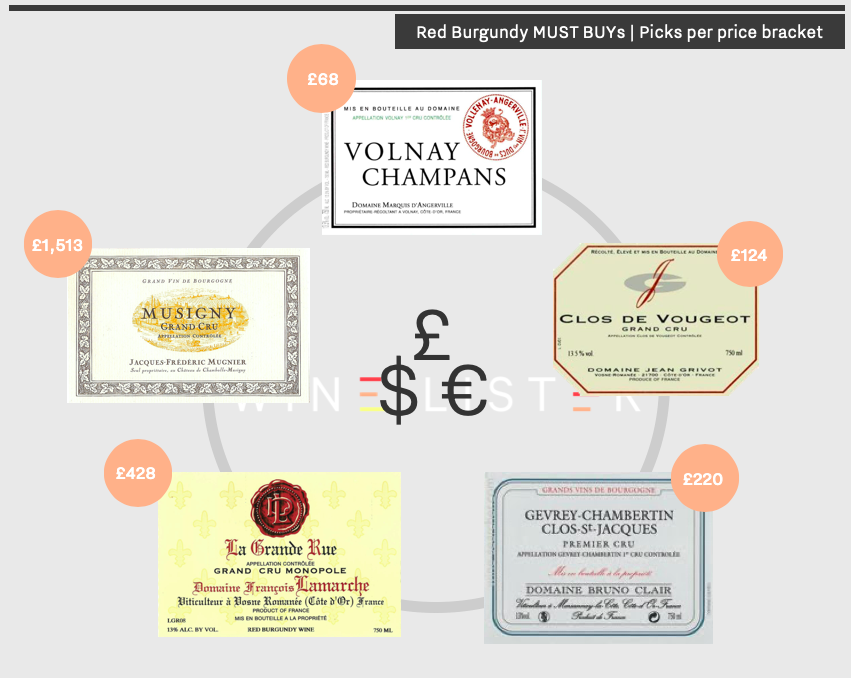 Prices are shown per bottle in-bond (when buying by the case).
Prices are shown per bottle in-bond (when buying by the case).
Under £75 – 2012 Marquis d’Angerville Volnay Champans
Marquis d’Angerville is widely considered one of the top producers in the Côte de Beaune, and the reference producer in Volnay. Indeed, the domain’s vineyards represent over 10% of all Premier Cru Volnay plantings. D’Angerville’s Volnay Champans is less than half of the cost of its flagship Volnay wine, Clos des Ducs. While both vineyards have south-easterly exposure, Clos des Ducs has calcareous, stony, white marl soil, while the soil in Champans is more clay-driven. The Champans is thus richer and fuller, while the Clos des Ducs (which also enjoys the highest elevation in Volnay) has more complexity and definition. The 2012 Marquis d’Angerville Volnay Champans performs particularly well, achieving a WL Score of 94 – this wine can be purchased from BI Wines & Spirits for £66.67 (per bottle in bond).
Under £150 – 2014 Jean Grivot Clos de Vougeot
Having taken over from his father Jean in 1990, Étienne Grivot (alongside his wife Marielle) has since adjusted his family’s viticultural and vinification methods. While completing his studies in general agriculture, viticulture, and oenology, Étienne noted that the over-fertilised Burgundian soil had become gradually less capable of producing vins de terroir. As well as reducing his overall yields, he now uses organic farming methods and natural yeasts to preserve the expression of where the grapes come from. The 2014 Clos de Vougeot has a WL Score of 94, and was described by Jancis Robinson as having “massively nuanced fruit” – this vintage can be purchased by the bottle from Wilkinson Vintners for £124 (in bond).
Under £350 – 2015 Bruno Clair Gevrey-Chambertin Clos Saint-Jacques
Bruno Clair’s Clos Saint-Jacques Premier Cru plantings are situated within a 6.7ha vineyard (shared with Sylvie Esmonin, Louis Jadot, Fourrier, and Armand Rousseau) encircled by a two-metre wall. Providing protection from prevailing winds, this fortification creates a micro-climate, which, alongside its steep south-easterly facing slope, enables consistent ripening. The 2015 vintage achieves a WL Score of 95. Wine Lister partner critic, Neal Martin describes it thus: “a hint of dark chocolate emanates from the oak infusing the red and black fruit toward the finish, and touches of marmalade and blood orange linger on the aftertaste”. This vintage is available to purchase from Cru World Wine, where the price of a bottle starts at £355 (in bond).
Under £500 – 2010 François Lamarche La Grande Rue
Having been elevated to Grand Cru status in 1992, La Grande Rue provides the setting for François Lamarche’s most prized domain – from which only c.5,500 bottles are produced per year. As of the 2007 vintage, François’ daughter, Nicole, has had total control of the winemaking, and has implemented organic viticulture (certified in 2010), which she believes makes vines more resilient to biotic stress. Described by Jancis Robinson as exhibiting “lovely freshness yet concentration and subtlety too”, the 2010 vintage achieves Lamarche La Grande Rue’s highest WL Score since its 1964 vintage (96), and is available to purchase from Corney & Barrow, where prices start at £540 per bottle (in bond).
Over £500 – 2008 Jacques-Frédéric Mugnier Musigny
Jacques-Frédéric Mugnier maintains his aim of preserving the purest expression of nature within his wine, with minimal interference from technological practices in the vineyard or the cellar. His Musigny is widely considered to be one of the greatest Burgundy reds, and has been described by Wine Lister’s Burgundy specialist critic, Jasper Morris as “brilliantly fragrant in bouquet and notably persistent on the finish”. With a WL Score of 96, the 2008 Jacques-Frédéric Mugnier Musigny is more difficult to source than the preceding wines, however, it is worth informing your merchant of your interest in purchasing it.
Like a virtual treasure map, Wine Lister’s Hidden gem indicator helps you discover fine wines that are under the radar, yet worth uncovering. These wines are seldom found in the top restaurants, infrequently searched for online, but have high ratings from wine critics, or are assigned “Hidden gem” status by the global fine wine trade.
Of the 1,639 wines that are currently recognised as MUST BUYs by Wine Lister’s proprietary recommendation algorithm, 87 are Hidden gems. To help you uncover these underrated wines, this week we examine the Hidden gem MUST BUYs with WL scores above 95.
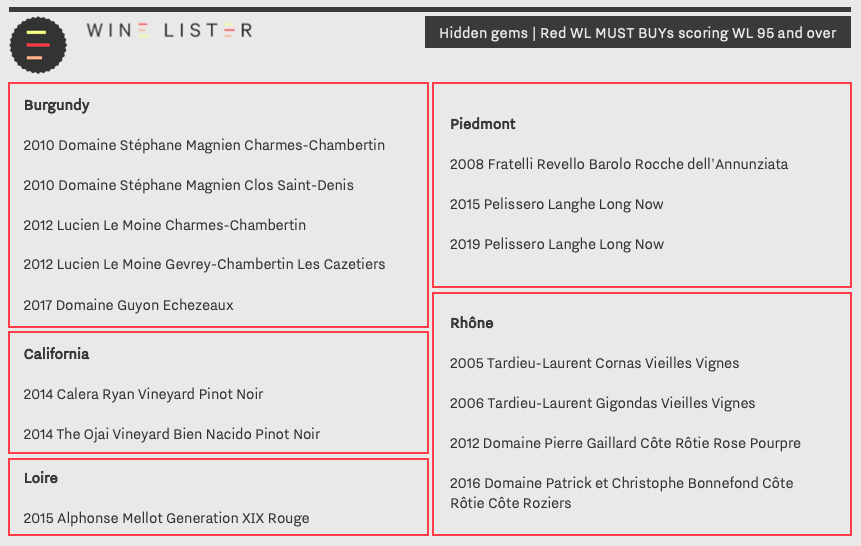
A preliminary look at the elected wines reveals a common trend of lower-than-average prices. While achieving WL scores of 95 and over, the 15 red Hidden gems illustrated above have an average price of £67 (per bottle in-bond) – perhaps a consequence of their slight obscurity. By virtue of being “Hidden gems”, these wines are also harder to source, however, it is worth informing your merchant of your interest in purchasing them, in the event of their availability.
Burgundy achieves five entries in this week’s subgroup, with two from a small-production négociant house, Lucien Le Moine. Well-deserving of their Hidden gem status, both wines achieve a WL score of 96. The 2012 Lucien Le Moine Charmes-Chambertin is available from Lay & Wheeler at £173 (per bottle in-bond), and the 2012 Lucien Le Moine Gevrey Chambertin Les Cazetiers can be purchased from BI Fine Wine & Spirits for £83 (per bottle in-bond).
California is represented by two wines of the same vintage and grape. The Ojai Vineyard Bien Nacido Pinot Noir 2014 hails from vines in Santa Barbara’s Santa Maria Valley, whose east-to-west face encourages the flow of cooling Pacific Ocean breezes, apt for the Burgundian variety. The Ryan Vineyard Pinot Noir 2014 from cult California producer, Calera, is produced from vines in several sites across the Central Coast.
Two entries from Rhône’s Tardieu-Laurent show notably good quality-to-price ratios, achieving “Value pick” status. With a WL Score of 96, the 2005 Cornas Vieilles Vignes is priced at £43 (per bottle in-bond), while the 2006 Gigondas Vieilles Vignes has a WL Score of 95 at £24.
A joint venture between two négociants, Dominique Laurent (of Burgundy fame), and Michel Tardieu (Rhône), Tardieu-Laurent is a boutique négociant operation. Buying young wines from growers across the Rhône, the domain completes maturation and blending, before bottling with no fining nor filtration. The 2005 Tardieu-Laurent Cornas Vieilles Vignes is available to purchase from Fine + Rare (in magnum form), and the 2006 Tardieu-Laurent Gigondas Vieilles Vignes can be bought from Wine Bourse (by the case of 12).
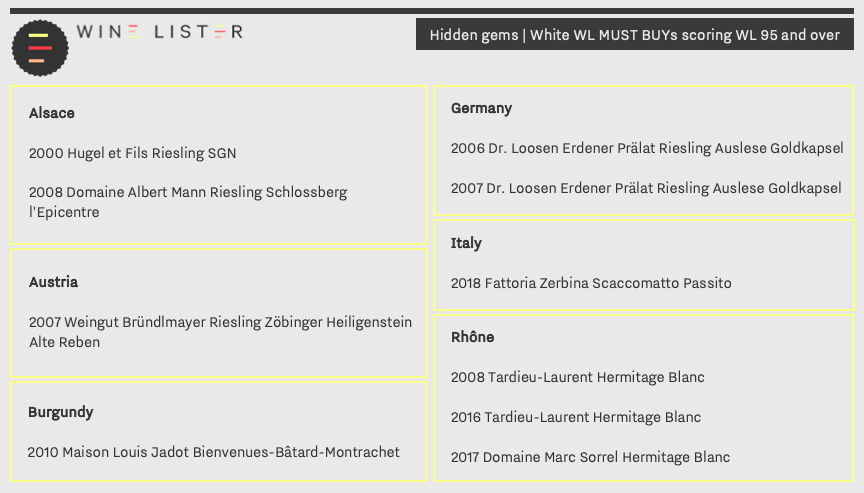
Tardieu-Laurent also features twice on the list of white Hidden gem MUST BUYs, with both its 2008 and 2016 Hermitages Blancs achieving WL Scores of 95.
Like their red counterparts, Tardieu-Laurent’s white Hidden gems are Value picks. Jancis Robinson pays compliment to both vintages, describing the 2008 as “Clean, intense, multilayered”, and the 2016 as “Very serious stuff”. Both wines can be purchased from Corney & Barrow (by the case of 12 in-bond).
Five out of the 10 white Hidden gems shown above are Riesling-based. There is no doubt that the noble grape can produce impressive quality wines at reasonable prices, though this remains somewhat of a fine wine trade secret (when compared with the consumer popularity of other white grape varieties and styles).
The two whites from Alsace cover icon Riesling producers Hugel and Albert Mann. Germany’s entries comprise of the 2006 and 2007 vintages of Dr. Loosen Erdener Prälat Riesling Auslese Goldkapsel, which achieve WL Scores of 96 and 95 respectively.
Loosen’s four-acre Erdener Prälat vineyard has south-facing red slate soils, and a notably warm microclimate, which, combined with the warming effect of the river and the heat-retaining cliffs that surround it, ensures ripeness in every vintage. The 2006 Dr. Loosen Erdener Prälat Riesling Auslese Goldkapsel can be purchased from Lay & Wheeler for £47 (per bottle in-bond).
To discover more of Wine Lister’s Hidden gem MUST BUYs, click here.
As shown in a recent post on using Wine Lister to build your portfolio, Burgundy is the best-represented region of Wine Lister’s MUST BUY hoard (33%, or 533 wines). 10% of these (161 wines) are white Burgundies, that show high quality and good value within their respective vintages and appellations. These wines cover a vast range of prices, from £15 (per bottle in-bond) up to £1,354.
This week’s blog post examines white Burgundy MUST BUYs at five different price points, to help the hunt of those buying fine wine at every level.
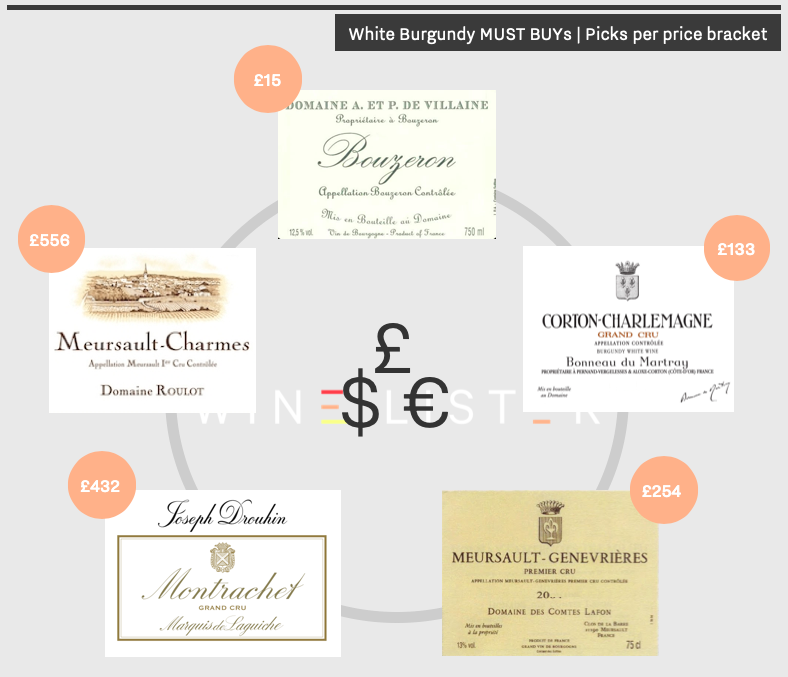 Prices are shown per bottle in-bond (when buying by the case).
Prices are shown per bottle in-bond (when buying by the case).
Under £20 – 2016 Domaine A. & P. de Villaine Bouzeron
Bouzeron’s location in the north of the Côte Chalonnaise provides the setting for Aubert de Villaine’s personal project – one with a humbler reputation than that of his magnum opus, Domaine de la Romanée-Conti. Dispelling the region’s once-unfavourable reputation, de Villaine’s restricted yields and hand-harvesting produces top quality Aligoté Doré. The 2016 vintage achieves a WL Score of 90, and was described by Neal Martin as having “a touch of salinity towards the finish with judicious hints of stem ginger and a hint of rhubarb”. This wine is available to purchase from Justerini & Brooks, where a case of six starts at £90 (in-bond).
Under £150 – 2015 Domaine Bonneau du Martray Corton-Charlemagne
Bonneau du Martray is the largest single owner of vines in Corton-Charlemagne – an appellation that is often said to rival Montrachet. The 2015 vintage was discussed in Wine Lister’s blog on the top 2015 white Burgundies by WL score, in which it was the second highest overall scorer. As of 2018, around 25% of Bonneau du Martray’s Corton-Charlemagne vineyards has been leased to Romanée-Conti – a factor that could drive its price up in the future. For now, this Corton-Charlemagne remains of exceedingly good value in the context of Grand Cru white Burgundy. The 2015 vintage can be purchased from UK merchants such as Goedhuis, where a case of six costs £916 (in-bond).
Under £350 – 2012 Domaine des Comtes Lafon Meursault Genevrières
Despite lacking the Grand Cru status held by Corton-Charlemagne, the higher cost of Domaine des Comtes Lafon’s Meursault Genevrières (Premier Cru) could in part be reflective of the increasing popularity of Meursault. Dominique Lafon is often considered one of the leading producers in Meursault, as reflected in his meticulous vinification process. Spending two winters in wood, and sleeping in some of the deepest and coldest cellars in the region, his wines are bottled nearly two years after harvest – one of the latest bottlings in Burgundy. Achieving a WL score of 94 and ‘Investment Staple’ status, the 2012 vintage is available to purchase from Four Walls Wine Co., where a bottle costs £225 (in-bond).
Under £500 – 2017 Maison Joseph Drouhin Montrachet Marquis de Laguiche
The second Grand Cru white Burgundy examined here is more expensive than Bonneau du Martray’s Corton-Charlemagne, but nonetheless also good value – this time in the context of Montrachet specifically. Hailing from négociant house Joseph Drouhin, its Montrachet Marquis de Laguiche is priced around £432, while the average price of all Montrachet 2017s on Wine Lister is £1,249. Sourcing grapes from vineyards owned by the Laguiche family, the quality here is just as impressive as several Montrachet wines produced by Burgundy domains. Achieving a WL score of 95, the 2017 vintage was described by Jancis Robinson as “Creamy, deep, powerful and endlessly long”. This wine is available to purchase from Berry Bros. & Rudd, where a case of six bottles starts at £2,750 (in-bond).
Over £500 – 2015 Domaine Roulot Meursault Charmes
The “blowout” wine of this week’s selection is Domaine Roulot’s Meursault Charmes. Having assumed direction of the estate in 1989, Jean-Marc Roulot has been successful in fine-tuning the distinct style of wine developed by his father, Guy Roulot. While many other wines of this village exhibit richness and concentration, the 2015 Meursault Charmes reflects Jean-Marc’s commitment to achieving a brighter style of Meursault – one which expresses its terroir vividly. Speaking on his aversion to excessive lees-stirring, he says, “I prefer to lose a little volume and power on the palate in order to obtain the ‘ligne droite’ [straight line] and the purity. This haunting purity and directness is evident in every wine Roulot produces.” The wine is available from several UK merchants, including Morgan Classic Wines, and Fine+Rare, from which prices start from £425 (per bottle in-bond).
An Easter weekend on lockdown presents as good a time as ever to evaluate your wine collection. While it can be tricky to keep track of what you’ve got and when you should drink it, Wine Lister’s various online tools allow detailed analysis of your collection and can guide future purchases, whether for drinking or investment.
This week’s blog post examines two of the most popular Wine Lister website features amongst collectors, starting with the MUST BUY recommendation tool.
Wine Lister’s proprietary recommendation algorithm produces a dynamic list of wines with high quality that show value within their respective vintages and appellations, helping wine lovers buying at almost every level to make the best choices for their desired region, style, or vintage.
There are currently 1,665 MUST BUYs out of the 30,000+ labels on Wine Lister. See the chart below for a breakdown of MUST BUYs by region – an indication of what a diverse portfolio could look like for the modern collector.
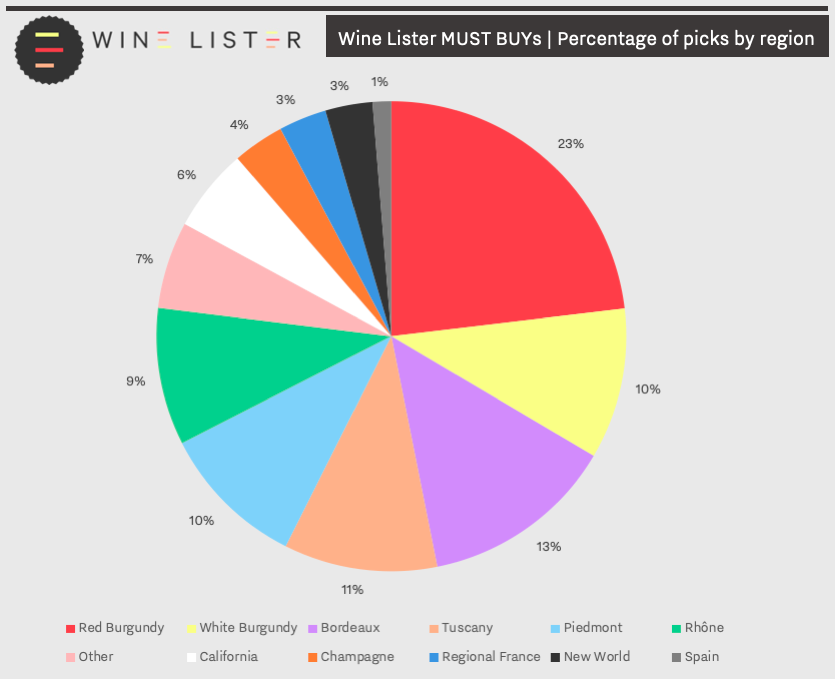
While the same chart from a decade ago may have been dominated by Bordeaux, the global demand and secondary market values for Burgundy’s top wines have continued to spiral upwards. Burgundy represents the greatest percentage of MUST BUY wines, with red and white recommendations accounting for 33% of all MUST BUYs collectively. The red Burgundian MUST BUYs feature a range of prices starting from the most expensive, DRC’s Romanée-Conti 2015 (available at £14,500 per bottle in-bond), down to 64 wines priced at £100 or under, including Stéphane Magnien’s Clos Saint-Denis 2010 (available at £76 per bottle).
Bordeaux represents 13% of MUST BUYS, and also encompasses a wide range of prices, from six vintages of Petrus (with an average price of £1,990 per bottle) down to two vintages of Marsau (priced at £12 and £13 respectively). Tuscany, Piedmont, and the Rhône follow closely behind, while California makes up the largest proportion of New world MUST BUYs.
With so much MUST BUY choice available, you may wish to filter these by top regions, and then further by Wine Lister Indicator. For example, filter results by ‘Investment staples’ to see wines that are long-lived (but not too old), and have proven wine price performance, while staying relatively stable and liquid.
Wine Lister’s Compare tool can then further refine your investigation, by displaying your selected MUST BUYs side by side. This is illustrated below using three 2016 Saint-Estèphe MUST BUYs – Cos d’Estournel, Calon Ségur, and Montrose. While Calon Ségur appears to be the best value, Montrose has the highest scores from Wine Lister’s partner critics, and therefore the better WL score overall.
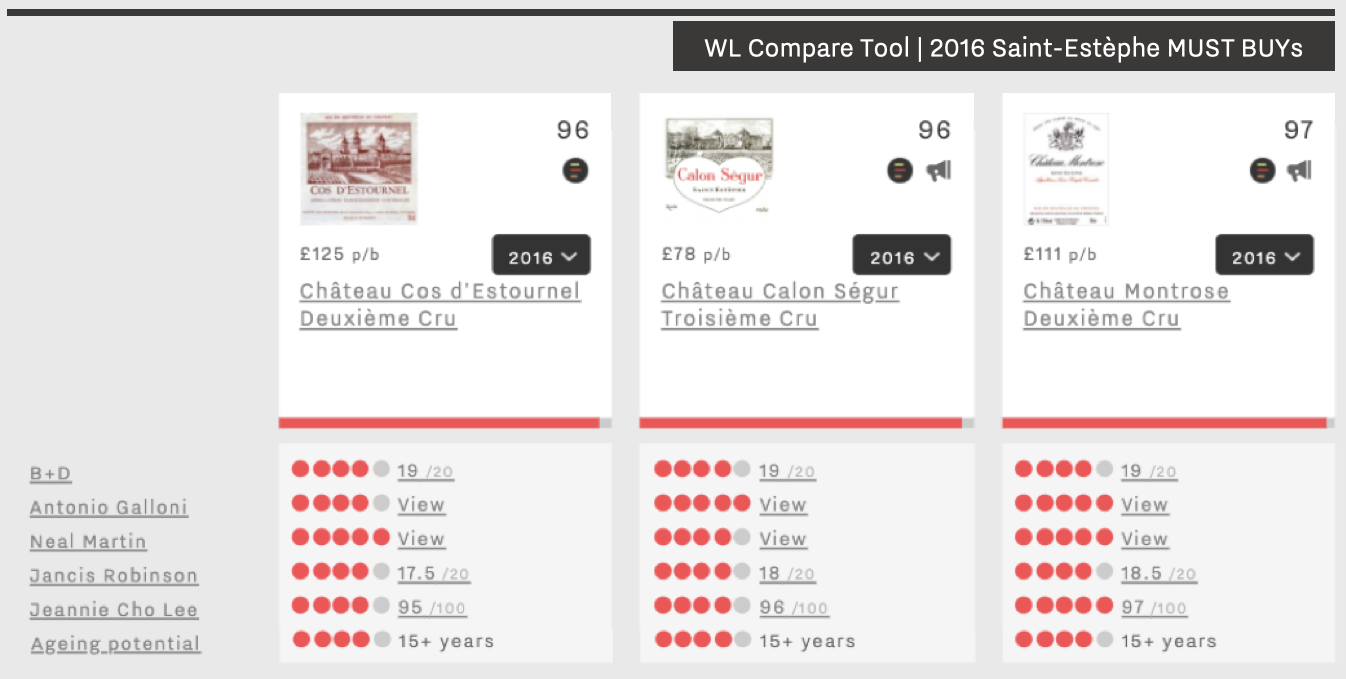
See the above comparison for yourself, or start your own wine comparison here.
Wine Lister is currently offering a range of portfolio analysis services to private clients, from detailed geographical split and further purchase advice, to investment forecasting and a fully-fledged “drink vs. sell” plan. If you are interested in having your wine collection analysed by our team of fine wine data experts, please don’t hesitate to contact us.
Earlier this week, we explored Wine Lister’s top red Value Picks (wines with the best quality-to-price ratios of all those in the Wine Lister database), noting that Tuscany and Bordeaux are the two best regions for value overall.
Having seen a noticeable lack of red Value Picks in Burgundy, the region’s white wines perform much better for quality-to-price ratio. The chart below shows the top eight regions for white Value Picks, and their average price per region.
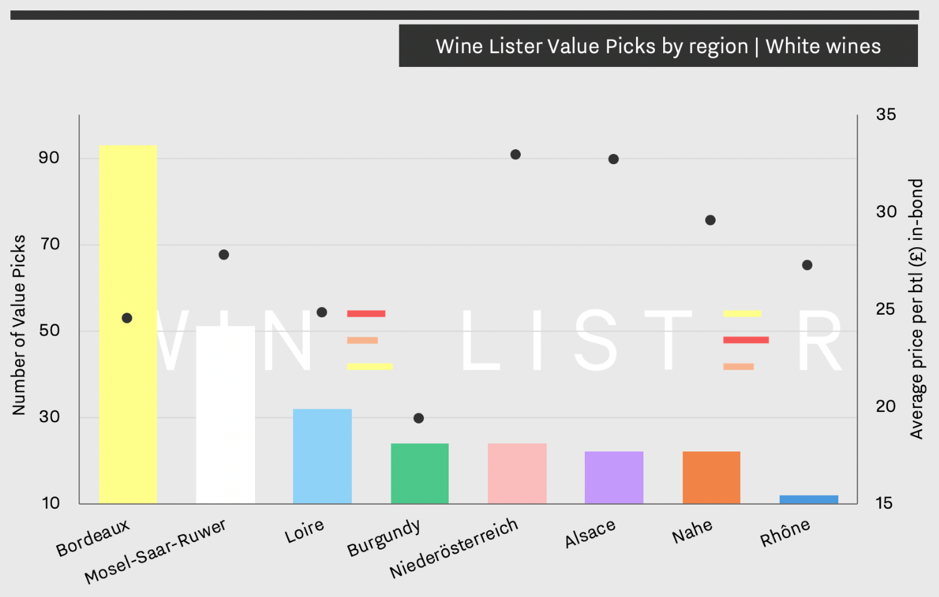
Of the 280 white Value Picks shown above, Bordeaux and the Mosel are heavily represented, in most part due to the impressive quality-to-price ratio of their sweet (or semi-dry) wines. Indeed, whites from Sauternes and Barsac make up all but one of the Bordeaux white Value Picks. While not the “most popular” these are some of the oldest Value Picks on Wine Lister, and include examples such as 1995 Clos Haut-Peyraguey, and 1996 Nairac.
The Loire provides a mix of different sweetness levels, however those achieving the highest quality are also sweet (such as 2006 Domaine Huet Clos du Bourg Moelleux).
Treading into Riesling-land, the Mosel and Nahe offer up the likes of Joh. Jos Prüm’s Wehlener Sonnenuhr Riesling Auslese Goldkapsel, and Dönnhoff’s Oberhäuser Brucke Riesling Auslese Goldkapsel. Alsace and Austria’s Niederösterreich produce some gems too (from the likes of Zind-Humbrecht and F.X. Pichler respectively), though of all white Value Picks these two regions are the most expensive on average.
Burgundy achieves 24 white Value Picks, the majority of which come from Chablis – the appellation which historically renders the best value for Burgundian whites. Other white Value Picks of note are Patrick Javillier’s Meursault Les Tillets, and Paul Pillot’s Chassagne-Montrachet Clos Saint-Jean.
See all white Value Picks here.
After discovering some 500 wines over eight tastings during Burgundy week last week, we are excited to publish our first round of Burgundy 2018 MUST BUYs.
Not all Burgundy 2018s are yet priced in the market, so this list has the potential to grow over the coming weeks – watch this space.
A neat 18 wines have so far made it through the MUST BUY algorithm, passing the artificial and human intelligence tests. That means that according to the critic and price data, they offer high quality and good value in the context of the Burgundy 2018 vintage, and that the global fine wine trade and / or the Wine Lister team deems it worthy of note. Given Burgundy’s general trend for rising prices post-release – these Burgundy 2018s should be snapped up now.
Hailing from across the Côte d’Or, this week’s MUST BUY selection confirms that no one appellation stands out in 2018, as outlined by our founder, Ella Lister, in her short vintage report published earlier in the week.
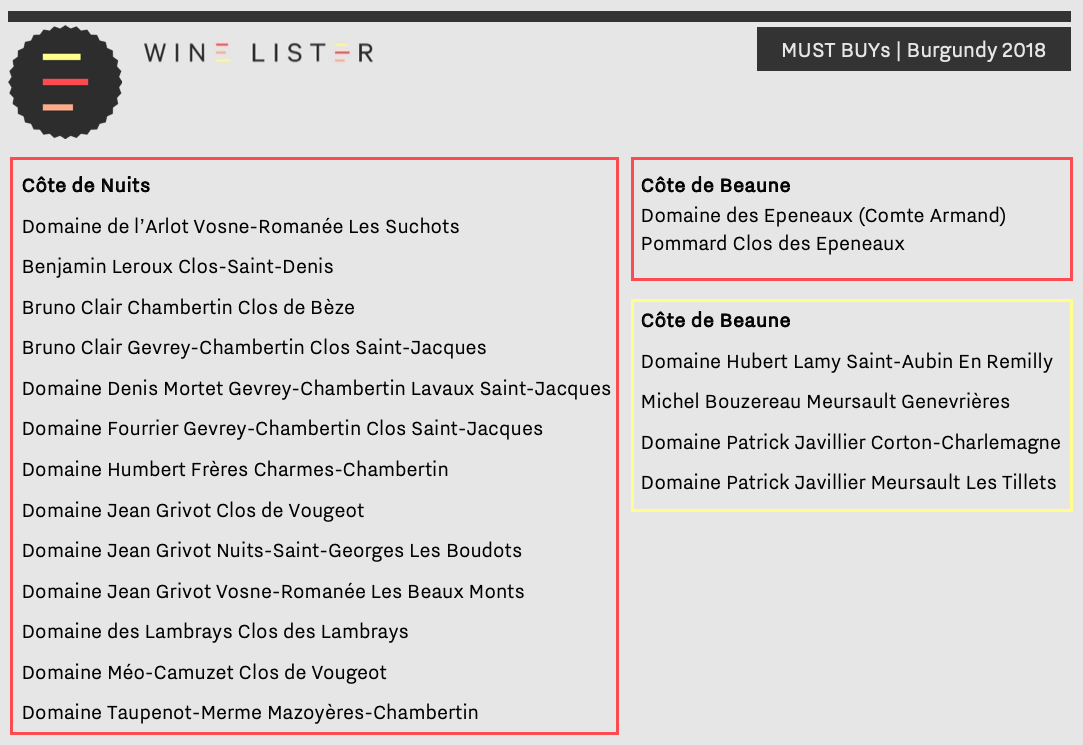
All but one red Burgundy 2018 MUST BUY comes from the Côte de Nuits, with producer Jean Grivot earning three entries – Clos de Vougeot, Nuits-Saint-Georges Les Boudots, and Vosne-Romanée Les Beaux Monts. Bruno Clair has two entries, for his Chambertin Clos de Bèze and Gevrey-Chambertin Clos Saint-Jacques.
From the Côte de Beaune, Comte Armand’s Clos des Epeneaux is the only red to meet all the MUST BUY selection criteria. Of the four whites, the unfailingly consistent Saint-Aubin En Remilly from Hubert Lamy makes the cut, alongside a Meursault Genevrières from Michel Bouzereau, and two wines from Patrick Javillier – Corton-Charlemagne and Value Pick Meursault Les Tillets.
Readers note that this week marks the first MUST BUY update including scores from our new regional partner critic, Jasper Morris.
Thank you to BBR, Corney & Barrow, Flint, Goedhuis, Justerini & Brooks, Lay & Wheeler, and Lea & Sandeman for the wonderful tastings organised!
 The biodynamic calendar: racking at Comtes Lafon (pictured) is timed according to the lunar phases (Photo: Jean Chevaldonné)
The biodynamic calendar: racking at Comtes Lafon (pictured) is timed according to the lunar phases (Photo: Jean Chevaldonné) Process 500: biodynamic compost preparations at Château Palmer
Process 500: biodynamic compost preparations at Château Palmer










